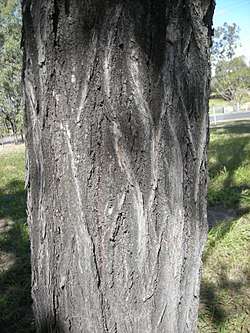Ironbark
Ironbark is a common name of a number of species in three taxonomic groups within the genus Eucalyptus that have dark, deeply furrowed bark.[1]

Instead of being shed annually as in many of the other species of Eucalyptus, the dead bark accumulates on the trees, forming the fissures. It becomes rough after drying out and becomes impregnated with kino (red gum), a dark red tree sap exuded by the tree.[2] The tree is so named for the apparent resemblance of its bark to iron slag. The bark is resistant to fire and heat and protects the living tissue within the trunk and branches from fire. In cases of extreme fire, where leaves and shoots are removed, the protective bark aids in protecting epicormic buds which allow the tree to reshoot.[3]
Being a very dense, hard wood, a length of ironbark is often used as a bug shoe on the bottom of a ship's skeg to protect it from shipworms.[4]
Examples of ironbark species
- Eucalyptus atrata L.A.S.Johnston & K.D.Hill, Herberton ironbark, blue-leaved ironbark
- Eucalyptus ancophila L.A.S.Johnson & K.D.Hill, ironbark
- Eucalyptus beaniana L.A.S.Johnson & K.D.Hill, Bean's ironbark
- Eucalyptus × beyeri F.Muell. ex R.T.Baker, Beyers's ironbark
- Eucalyptus caleyi Maiden, Caley's ironbark, drooping ironbark
- Eucalyptus corynodes A.R. Bean & Brooker, ironbark
- Eucalyptus crebra F.Muell., narrow-leaved ironbark or narrow-leaved red ironbark
- Eucalyptus cullenii L.A.S.Johnson & K.D.Hill, Cullen's ironbark
- Eucalyptus crebra F. Muell., narrow-leaved (red) ironbark
- Eucalyptus decolor A.R.Bean & Brooker, ironbark
- Eucalyptus decorticans (F.M.Bailey) Maiden, gum-topped ironbark
- Eucalyptus drepanophylla F.Muell. ex Benth., bowen ironbark, narrow-leaved ironbark or narrowleaf red ironbark
- Eucalyptus dura L.A.S. Johnson & K.D.Hill, smooth-branched ironbark or gum-topped ironbark
- Eucalyptus exilipes Brooker & A.R.Bean, fine-leaved ironbark
- Eucalyptus farinosa K.D.Hill, ironbark
- Eucalyptus fibrosa F. Muell., broad-leaved (red) ironbark, blue-leaved ironbark
- Eucalyptus fusiformis Boland & Kleinig, gray ironbark
- Eucalyptus granitica L.A.S.Johnson & K.D.Hill, granite ironbark
- Eucalyptus indurata Brooker & Hopper, ironbark
- Eucalyptus jensenii Maiden, wandi ironbark or isdell river ironbark
- Eucalyptus melanoleuca S.T.Blake, blackdown ironbark, yarraman ironbark or nanango ironbark
- Eucalyptus melanophloia F.Muell., silver-leaved ironbark
- Eucalyptus ophitica L.A.S.Johnson & K.D.Hill, serpentine ironbark
- Eucalyptus panda S.T. Blake, Brogan's ironbark, tumble-down ironbark, corky ironbark
- Eucalyptus paniculata Sm., grey ironbark
- Eucalyptus paedoglauca L.A.S.Johnson & Blaxell, Mount Stuart ironbark
- Eucalyptus placita L.A.S.Johnson & K.D.Hill, ironbark
- Eucalyptus quadricostata Brooker, square-fruited ironbark
- Eucalyptus rhombica A.R. Bean & Brooker, diamondfruit ironbark
- Eucalyptus scopulorum K.D.Hill, ironbark
- Eucalyptus shirleyi Maiden, Shirleys's silver leaved ironbark
- Eucalyptus sicilifolia L.A.S.Johnson & K.D.Hill, ironbark
- Eucalyptus siderophloia Benth., Northern Grey Ironbark
- Eucalyptus sideroxylon A.Cunningham ex Woolls, red ironbark or Mugga
- Eucalyptus suffulgens L.A.S.Johnson & K.D.Hill, ironbark
- Eucalyptus taurina A.R.Bean & Brooker, helidon ironbark
- Eucalyptus placita L.A.S.Johnson & K.D.Hill, Grey Ironbark
- Eucalyptus staigeriana F. Muell. ex Bailey, lemon ironbark, lemon-scented ironbark
- Eucalyptus tricarpa (L.A.S.Johnson) L.A.S.Johnson & K.D.Hill, red ironbark
- Eucalyptus virens Brooker & A.R.Bean, greene-leaved ironbark
- Eucalyptus whitei Maiden & Blakely, White's ironbark
See also
References
- Ian Brooker, "Botany of the Eucalypts" in J.J.W. Coppen, Eucalyptus, 3-35, Boca Raton, Florida: CRC Press, 2002 ISBN 0-415-27879-1, p. 31
- CSIRO Forest Products Newsletter 1946
- J.B. Reid & B.M. Potts, "Eucalypt Biology" in Reid et al. (eds.), Vegetation of Tasmania, Australian Government, 2005, pp. 198-223
- "AFSC Historical Corner: Scoter, the Agency's Bristol Bay Boat". NOAA. Retrieved 6 April 2018.CS1 maint: ref=harv (link)
External links
- . New International Encyclopedia. 1905.